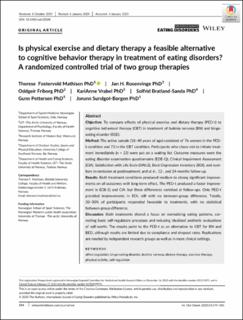| dc.contributor.author | Mathisen, Therese Fostervold | |
| dc.contributor.author | Rosenvinge, Jan H | |
| dc.contributor.author | Friborg, Oddgeir | |
| dc.contributor.author | Vrabel, KariAnne | |
| dc.contributor.author | Bratland-Sanda, Solfrid | |
| dc.contributor.author | Pettersen, Gunn | |
| dc.contributor.author | Sundgot-Borgen, Jorunn | |
| dc.date.accessioned | 2020-08-31T08:03:51Z | |
| dc.date.available | 2020-08-31T08:03:51Z | |
| dc.date.created | 2020-01-16T20:09:23Z | |
| dc.date.issued | 2020 | |
| dc.identifier.citation | Mathisen, T. F., Rosenvinge, J. H., Friborg, O., Vrabel, K., Bratland‐Sanda, S., Pettersen, G., & Sundgot‐Borgen, J. (2020). Is physical exercise and dietary therapy a feasible alternative to cognitive behavior therapy in treatment of eating disorders? A randomized controlled trial of two group therapies. International Journal of Eating Disorders, 53(4), 574-585. | en_US |
| dc.identifier.issn | 0276-3478 | |
| dc.identifier.uri | https://hdl.handle.net/11250/2675614 | |
| dc.description.abstract | Objective: To compare effects of physical exercise and dietary therapy (PED‐t) to cognitive behavioral therapy (CBT) in treatment of bulimia nervosa (BN) and binge‐eating disorder (BED). Method: The active sample (18–40 years of age) consisted of 76 women in the PED‐t condition and 73 in the CBT condition. Participants who chose not to initiate treatment immediately (n = 23) were put on a waiting list. Outcome measures were the eating disorder examination questionnaire (EDE‐Q), Clinical Impairment Assessment (CIA), Satisfaction with Life Scale (SWLS), Beck Depression Inventory (BDI), and numbers in remission at posttreatment, and at 6‐, 12‐, and 24‐months follow‐up. Results: Both treatment conditions produced medium to strong significant improvements on all outcomes with long‐term effect. The PED‐t produced a faster improvement in EDE‐Q and CIA, but these differences vanished at follow‐ups. Only PED‐t provided improvements in BDI, still with no between‐group difference. Totally, 30–50% of participants responded favorable to treatments, with no statistical between‐group difference. Discussion: Both treatments shared a focus on normalizing eating patterns, correcting basic self‐regulatory processes and reducing idealized aesthetic evaluations of self‐worth. The results point to the PED‐t as an alternative to CBT for BN and BED, although results are limited due to compliance and dropout rates. Replications are needed by independent research groups as well as in more clinical settings. | en_US |
| dc.language.iso | eng | en_US |
| dc.relation.uri | https://onlinelibrary.wiley.com/doi/epdf/10.1002/eat.23228 | |
| dc.rights | Navngivelse 4.0 Internasjonal | * |
| dc.rights.uri | http://creativecommons.org/licenses/by/4.0/deed.no | * |
| dc.title | Is physical exercise and dietary therapy a feasible alternative to cognitive behavior therapy in treatment of eating disorders? A randomized controlled trial of two group therapies | en_US |
| dc.type | Peer reviewed | en_US |
| dc.type | Journal article | en_US |
| dc.description.version | publishedVersion | en_US |
| dc.rights.holder | © 2020 The Authors. | en_US |
| dc.source.pagenumber | 574-585 | en_US |
| dc.source.volume | 53 | en_US |
| dc.source.journal | International Journal of Eating Disorders | en_US |
| dc.source.issue | 4 | en_US |
| dc.identifier.doi | https://doi.org/10.1002/eat.23228 | |
| dc.identifier.cristin | 1775298 | |
| cristin.ispublished | true | |
| cristin.fulltext | original | |
| cristin.qualitycode | 2 | |

